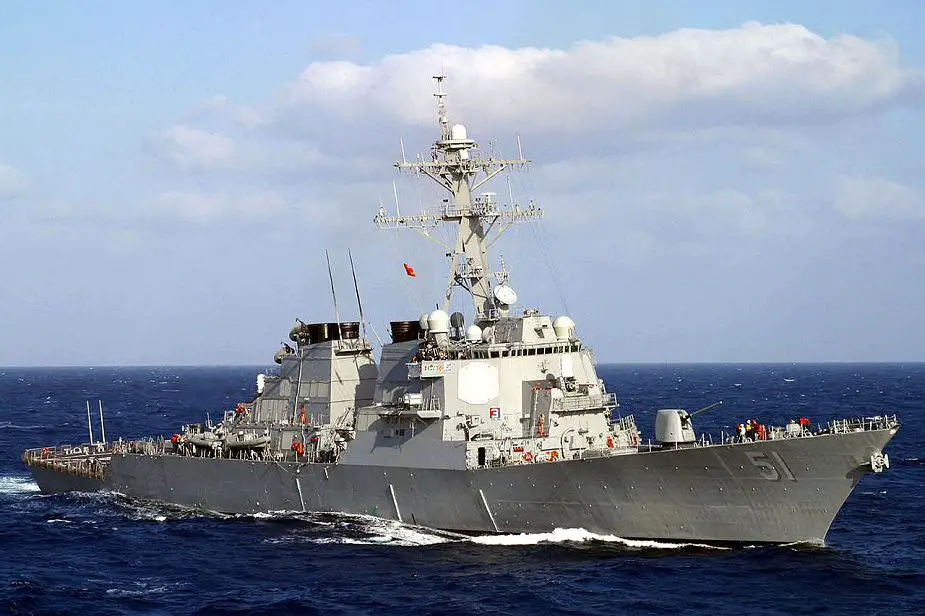Breaking news
Northrop Grumman to procure integrated bridge and navigation systems for Arleigh Burke DDG-51 guided missile destroyer.
On May 1, 2020, Northrop Grumman Systems Corp., Charlottesville, Virginia, is awarded a $27,430,321 firm-fixed-price, cost-plus-fixed-fee and cost-only modification to previously awarded contract N00024-19-C-4101 to exercise options to procure integrated bridge and navigation systems for the DDG-51 guided missile destroyer New Construction Ship Program and DDG-51 Midlife Modernization Program with physical throttles kits and engineering services.
 U.S. Navy guided missile destroyer USS Arleigh Burke DDG 51. (Picture source US Navy)
U.S. Navy guided missile destroyer USS Arleigh Burke DDG 51. (Picture source US Navy)
The Arleigh Burke (DDG 51) class guided missile destroyers provide a wide range of warfighting capabilities in multi-threat air, surface and subsurface environments. These ships respond to Low Intensity Conflict/Coastal and Littoral Offshore Warfare (LIC/CALOW) scenarios as well as open-ocean conflict independently or as units of Carrier Strike Groups (CSG), Surface Action Groups (SAG), and Expeditionary Strike Groups (ESG). Named after famed World War II Officer and former Chief of Naval Operations, Admiral Arleigh Burke, this class provides outstanding combat capability and survivability characteristics while considering procurement and life cycle support costs.
Arleigh Burke class destroyers are equipped with the Navy’s Aegis Weapon System, the world’s foremost integrated naval weapon system. When integrated with the Aegis Combat System, the Cooperative Engagement Capability (CEC) will permit groups of ships and aircraft to link their radars to provide a composite picture of the battle space, effectively increasing the theater space. The capability is designed to provide the Navy with a 21st century fighting edge.
Like most modern U.S. Navy surface combatants, the Arleigh Burke class utilizes gas turbine propulsion. Employing four General Electric LM 2500 gas turbine engines to produce 100,000 total shaft horsepower via a dual shaft design, these ships are capable of achieving 30-plus knot speeds in open seas.
The Arleigh Burke class employs all-steel construction and comprises four separate variants or "Flights." DDG 51-71 represent the original design and are designated as Flight I ships; DDG 72-78 are Flight II ships; DDGs 79-116 are Flight IIA ships in service, and will continue through DDGs 124 and 127. The Flight III baseline will begin with DDGs 125-126, and continue with DDGs 128 and follow. The first Flight III ship, DDG 125, started fabrication May 07, 2018.
The DDG 51 Flight III upgrade is centered on the AMDR/SPY-6(V)1 Air and Missile Defense radar system that provides improved capability over DDG 51 Flight IIA ships. The AMDR enables Flight III ships to simultaneously perform Anti-Air Warfare (AAW) and Ballistic Missile Defense (BMD), which satisfies the Navy’s critical need for an enhanced surface combatant Integrated Air and Missile Defense (IAMD) capability.
Sixty-seven DDG 51 class ships have been delivered to the fleet (DDG 51-DDG 117). Twenty-one ships are currently under construction contract with shipbuilders Huntington Ingalls Industries, Ingalls Shipbuilding, and General Dynamics Bath Iron Works including the recent award of 11 Flight III ships under the FY 2018-2022 Multiyear Procurement. The MYP continues the procurement for the proven DDG 51 Class shipbuilding program, leveraging competition, a strong industrial base and a stable design in order to achieve savings.





























